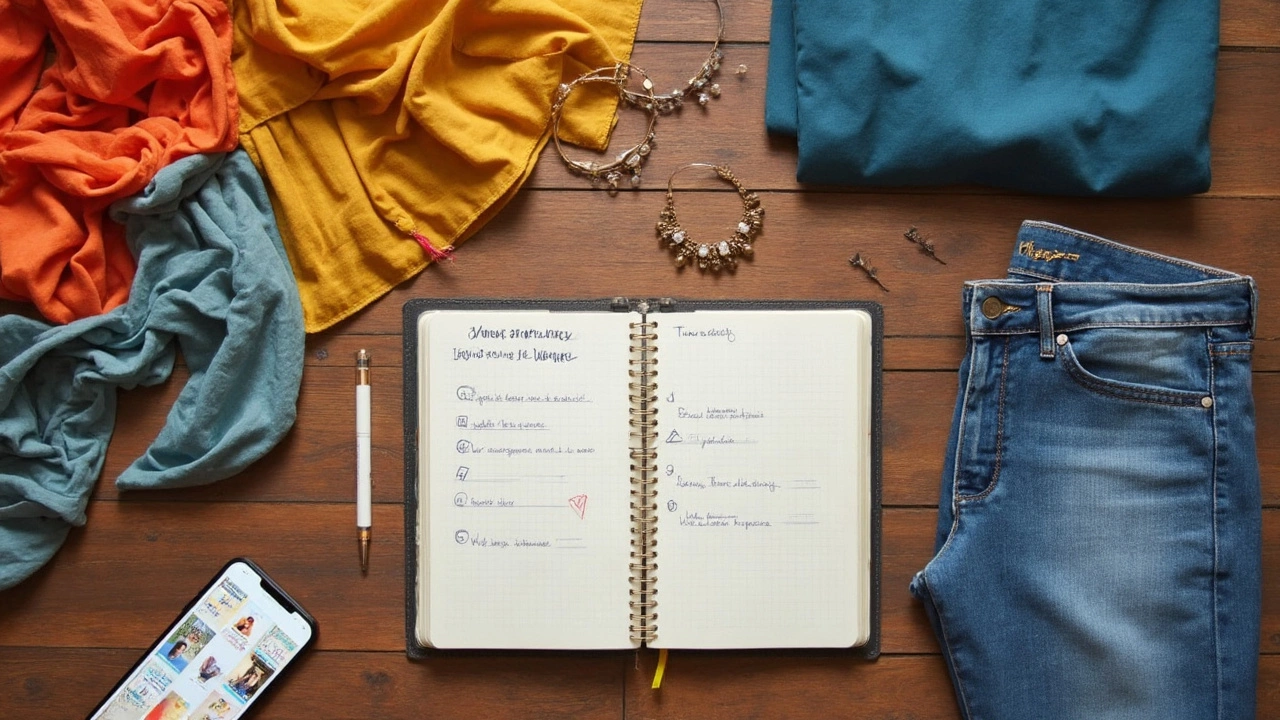If having a closet packed with clothes but nothing to wear sounds familiar, you’re not alone. The 33 wardrobe rule shakes things up and asks a simple but daring question: what if you dressed with just 33 things for three whole months? Imagine opening your closet every morning and loving every single option, no overwhelm, and no stress. That’s the magic behind this buzzy, game-changing approach to clothing. People all over the world are ditching closet chaos and testing this minimalist rule—and seeing real benefits. But how does it work, and can it actually make getting dressed easier, cheaper, or more stylish?
Where Did the 33 Wardrobe Rule Start?
Ever heard of Courtney Carver? Back in 2010, she kicked off Project 333 after feeling weighed down—literally and emotionally—by too much stuff and a hectic lifestyle. She challenged herself to pick just 33 pieces of clothing (shoes, accessories, outerwear included, but not pajamas, underwear, or workout gear you only wear to exercise) and commit to wearing only those for three months. Crazy? Maybe. But within weeks, she noticed she wasn’t just making fashion choices; she was spending less time stressing, saving money, and feeling lighter in her day-to-day life.
It took off. Project 333 started as a personal challenge, but soon people everywhere were posting about shrinking their closets, showing before-and-after photos, and celebrating how much better they felt. If you check the hashtag “#project333” even now, you’ll find folks of all ages and styles getting creative with way fewer clothes. The idea caught the eye of fashion journalists and even psychologists who found that cluttered spaces, yes, even closets, can spike anxiety and waste brain energy on “decision fatigue.” So the 33 wardrobe rule isn’t just a style trend—it’s rooted in psychology and proven by lots of real people.
Here’s a table with some numbers and facts from an actual survey run by BeMoreWithLess (Courtney Carver’s website):
| Survey Question | Percentage of Participants |
|---|---|
| Felt happier after doing Project 333 | 78% |
| Reported saving money on clothes | 67% |
| Got ready faster in the morning | 81% |
| Kept up with 33 wardrobe rule past three months | 55% |
What Counts As Part of the 33 Wardrobe Rule?
This is the number one thing that trips people up. The most common question is, “Wait, does this mean 33 shirts, or is that 33 in total?” Spoiler: it’s 33 total items. That includes your clothing, shoes, coats or jackets for that season, and everyday accessories (think hats, belts, bags, but not sentimental jewelry like wedding bands). Don’t worry about underwear, sleepwear, or activewear you only wear to work out—those are your free passes.
Let’s break it down for clarity:
- Tops (shirts, blouses, sweaters)
- Bottoms (pants, jeans, skirts)
- Dresses (if you wear them)
- Shoes (all types included, so choose wisely!)
- Jackets or coats (depends on the weather and your location)
- Accessories (scarves, hats, jewelry, bags—just day-to-day basics you love and use)
Most folks worry 33 is way too little. But take a real look at your closet—how often do you wear everything there? Studies show most people wear only 20% of their clothes 80% of the time. Sticking to 33 favorite items isn’t as harsh as it sounds. Those “what if I need this one day” pieces? They usually just take up space and drain energy.
Here’s a practical tip: Pick your favorite pieces first. These are the items you reach for without thinking. Then fill in the gaps with basics you know you’ll wear, and add a few special items for variety. If the weather shifts a lot where you live, look at the three-month block as a season, and plan accordingly.

How the 33 Wardrobe Rule Improves Your Life
The perks go way past having a neat closet (though, let’s be honest, that part is amazing). You’ll probably save cash—when you’re sticking to 33, impulse buys and shopping “just because” become rare. Some people report halving their clothing budget after starting this experiment. With fewer options, “what should I wear?” stops feeling like a daily brain workout. You could spend that saved time having an extra cup of coffee or reading headlines.
Getting rid of closet clutter also helps you figure out your real style. You see patterns—maybe most of your favorite clothes are blue, or you love one type of pant. It gets clearer what fits, what flatters, and what you feel good wearing. You buy less, but what you buy fits your needs, not trends or sales tactics. I’ve known people who realized, after trimming down, that black jeans, white T-shirts, and one good jacket were most of what they ever wore. Everything else? Donated or sold online, making room for the actual stars of their style game.
There’s also a hidden benefit: environmental impact. Fashion is one of the world’s most polluting industries—according to the United Nations, the fashion industry produces 10% of global carbon emissions every year. When you cut down your closet, you buy less, waste less, and help the planet breathe easier. One study from Greenpeace found that if everyone in Europe wore their clothes just nine months longer, it would reduce carbon, water, and waste footprints by 20-30%. Minimalism really does matter.
Here’s what a week might look like using just a handful of versatile items:
- 2 pairs of pants
- 1 skirt or shorts
- 3 T-shirts
- 2 sweaters or sweatshirts
- 1 blazer
- 1 jacket
- 2 pairs of shoes (maybe sneakers and loafers)
Mix and match, and suddenly you’ve got over a dozen outfit combos. Add some simple accessories, and no one can tell (or care) how many pieces you own.
Tips for Starting Your Own 33 Wardrobe Rule
If you’re curious but nervous about starting, here are some tried-and-true tricks:
- Take everything out of your closet. Yes, the whole thing. Lay it out where you can see it.
- Sort your items. Pull your absolute must-haves—the ones you genuinely wear all the time.
- Pick for your lifestyle. Do you work in an office? Stay home with kids? Walk a lot? Be honest with what you need.
- Layer up. If in doubt, stick with items that work for layering. Tank tops under shirts, or sweaters over tees, keep things fresh through weather changes.
- Add a little play. Save a spot or two for a “wild card” piece—a bright scarf or funky shoes for fun.
- Box up the rest. Don’t toss everything yet; store it for three months just in case.
- Commit for three months. Treat it as an experiment. Are you happier? Did anyone notice? (Spoiler: usually, friends don’t.)
- Adjust as needed. At the end of your test, swap out items or tweak your choices. This isn’t about suffering; it’s about making life smoother.
Most folks trip over shoes and jackets. If you live somewhere the weather is unpredictable, focus on layers and choose a neutral raincoat or all-weather boots. If you’re struggling to downsize, try keeping sentimental or special-occasion stuff aside for now—it doesn’t count unless you actually use it daily.
And remember—there are no fashion police. If you mess up or hate your picks, swap them out. You’ll still learn plenty from the process.

Frequently Asked Questions About the 33 Wardrobe Rule
There’s always plenty of skepticism and heaps of curiosity around this idea, so here are answers to some of the top questions:
- Can I really do this if I love shopping? Yes, but it might change how you shop. Most people find they buy less but actually get more excited about new things—they’re more thoughtful and less likely to impulse shop.
- What if I have an unpredictable schedule? Pick basics that you can dress up or down. A good pair of jeans, a classic tee, and one sharp blazer can serve you basically anywhere—from groceries to dinner with friends.
- Do I have to follow this forever? Not at all. Plenty of people try it as a personal challenge. Some end up loving the simplicity and stick with it; others go back to a bigger closet, but most say their shopping habits shift for the better either way.
- Is this just for women? Nope. Men, teenagers, anyone can get the perks. The approach doesn’t care about gender, just about keeping things simple.
- What about special stuff like hiking boots or snow gear? Store those off-season or specialty items separately if you don’t use them daily. Only count what’s part of your everyday rotation.
- Won’t people notice me wearing the same thing all the time? Honestly, most folks are way too busy focusing on themselves. In fact, when you pick favorite, high-quality pieces, you look sharper and more polished than when you’re lost in a mix of rarely worn clothes.
The 33 wardrobe rule isn’t about deprivation. It’s really about focus—streamlining your closet, reducing hassle, and making choices based on what fits your life and your style right now. The freedom most people discover isn’t just great for mornings and budgets; it’s a real confidence booster, too. Want a closet that works for you instead of against you? Try the 33 rule. You might just find life is easier when your wardrobe is smaller but smarter.



